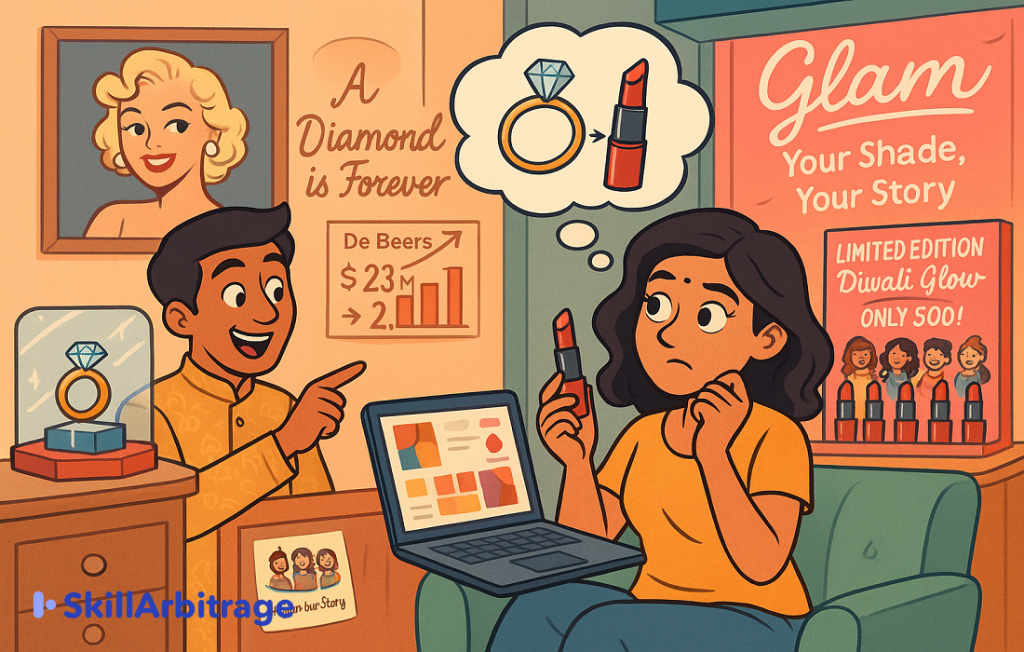De Beers created history with a campaign that impacted global cultural traditions. This blog is an in-depth study of how the same magic can work for the smallest Indian brands. This blog would be very useful for content strategists, content writers, and marketing experts.
Table of Contents
Introduction
This year, the wedding season started with a bang, one of my closest friends, Raja, was getting married. I was happy for him and his girlfriend of seven long years.
But, let me tell you, this joy really got tested. Why? Well, because as his ‘female bestie’, I was roped into the great Indian wedding trousseau mission. And boy, was it intense—from Sherwani looks, to theme functions, to flower arrangements. My mind was a Pinterest board at that point.
And the timing? Oh, it was convenient. I had to crack an idea for a digital campaign for Glam, the small lipstick brand I worked with. The sales were decent, and the consumer was small but loyal. Still, we needed something fresh, something that could help the brand break out of its cozy niche and grab attention in a crowded market sustainable brand strategy. Something that will keep expanding the consumer base and grabbing eyeballs.
So, there I was, mentally juggling wedding drama and brand strategy, sitting at a jeweller’s shop, watching Raj hunt for wedding rings. I watched him as he was trying to find a perfect wedding ring, that could also match the engagement ring he had already gifted his wife. I knew it was going to be a draining afternoon.
But, suddenly, his face lit, not just from good lighting, but he had found it.
And that’s when it hit me.
Diamonds.
They are not just stones. It is about what they represent. The “forever” love thing.
But diamonds were not always seen like that. Actually, their status as a mark of ultimate love was manufactured.
Back in the 1800s, South African mines had uncovered a massive supply of diamonds, and the market was flooded, which led to a drop in prices. So, contrary to popular beliefs, diamonds are not rare They are one of Earth’s most common gemstones, with billions of carats in reserves.
By 1888, De Beers, under British control, formed a cartel to monopolize supply, restricting output to maintain high prices.
But supply control alone wasn’t enough.
During the Great Depression, demand plummeted, and diamonds were seen as a luxury, not a necessity. In 1939, De Beers’ annual sales were a modest $23 million.
They knew they needed something radical, not just economics, but a cultural shift.
So what did they do?
They made advertising history.
The legendary campaign: “A Diamond is Forever”
In 1938, De Beers hired N.W. Ayer, a New York ad agency, to burnish diamonds’ image in the U.S., where engagement rings were rarely diamond-studded (only 10% of first-time brides received one in 1940).
The agency’s strategy was a gutsy call, but it paid off. They linked diamonds to romance, making them indispensable for proposals.
In 1947, copywriter Frances Gerety penned “A Diamond is Forever,” a tagline that became the century’s greatest.
It tied diamonds to eternal love, implying that, like love, diamonds were indestructible and never resold, preserving market value.
This was instrumental in changing how people across the world looked at diamonds and love.
But De Beers didn’t stop at a slogan. They went out with a campaign that hit every angle.
Hollywood glamour: Diamonds adorned stars like Marilyn Monroe, who sang “Diamonds Are a Girl’s Best Friend” in Gentlemen Prefer Blondes (1953), an early branded content coup.
(Source: MARILYN MONROE- DIAMONDS ARE A GIRL’S BEST FRIEND(LYRICS/TEKST))
Socialite endorsements
Portraits of “engaged socialites” wearing diamonds were fed to newspapers, an image carefully constructed to aspire the working middle- class.
Educational outreach
Lecturers visited high schools, preaching to young girls that diamond rings were engagement essentials.
Price anchoring
The “two months’ salary” rule was introduced, framing diamonds as not just a gift, but as a meaningful investment in love and commitment.
(Source:https://medium.com/@wkyler93/de-beers-2-month-salary-now-3-engagement-ring-custom-141f8e687a87)
The impact: a cultural shift
The results were staggering. By 1979, De Beers’ sales soared to $2.1 billion, a huge increase from 1938.
By 1990, 80% of U.S. first-time brides received diamond rings, a huge increase from 10% in 1940.
(Source: https://www.statista.com/statistics/238115/share-of-brides-in-the-us-with-a-diamond-engagement-ring/)
De Beers didn’t just sell diamonds; they invented a global tradition, making diamond engagement rings a global norm.
Case in point, even eighty years later, my friend had already gifted one to his bae to signal love, and now he was looking for another.
The marketing genius is undeniable.
I was wondering…was the strategy relevant today? Could I learn something from it to build a campaign for Glam?
Here are the five things I found.
5 takeaways for Glam: making lipsticks the new diamonds
Glam, a small Indian lipstick brand, faces a crowded market where giants dominate shelf space and consumer mindshare.
Small brands in India struggle with high churn and price sensitivity. Here’s how Glam can borrow De Beers’ playbook to make its lipsticks as aspirational as diamonds.
1. Create an emotional narrative
De Beers’ lesson: De Beers didn’t sell stones; they sold eternal love. The “A Diamond is Forever” tagline linked diamonds to love fulfilled, the most universal emotion possible.
How Glam can apply it: Glam must position its lipsticks as more than makeup. A symbol of confidence, individuality, and aspiration, especially for India’s Gen Z and millennial women.
I could craft a tagline like “Glam: Your Shade, Your Story” to evoke empowerment, highly relevant for women with buying power, most of Glam’s potential market.
I could expand it by launching a social media campaign and asking the audience to share stories of real women, students, professionals, homemakers, and artists with real stories about how Glam shades transformed their day.
These stories could be featured on Glam’s Instagram page as reels and posts, tying lipsticks to emotional milestones, like acing a job interview, celebrating a promotion or feeling loved at home.
2. Engineer perceived scarcity
De Beers’ Lesson: De Beers controlled diamond supply to create artificial scarcity, making them seem rare and valuable. This drove demand and justified high prices.
How Glam can apply it: Glam can’t stockpile lipsticks like De Beers did with diamonds, but it can create limited-edition shades to drive urgency. What it can do instead is create limited-edition shades or collections to spark urgency, a tactic that works in India’s impulse-driven market with a huge number of unplanned purchases.
These limited products can be promoted with countdown timers on Glam’s website and Instagram with exclusivity highlighting phrases like “Only 500 tubes available.”
3. Leverage influencer and cultural tie-ins
De Beers’ Lesson: De Beers used Hollywood stars and socialites to make diamonds aspirational, embedding them in pop culture via films and media.
How Glam can apply it: In India, micro-influencers, ones with (10K–100K followers), drive 80% of beauty engagement, offering authenticity at lower costs.
I could facilitate a tie-up between Glam and regional beauty influencers in cities like Mumbai, Delhi, and Bengaluru to showcase Glam shades in tutorials or “get ready with me” reels or festival looks.
4. Set a value anchor
De Beers’ Lesson: The “two months’ salary” rule gave men a clear benchmark, making diamond purchases feel justified and aspirational.
How Glam Can Apply It: I could also anchor Glam’s value to quality and impact instead of waging a price war with bigger competitors like Maybelline.
I could position a ₹499 lipstick, of higher value than the ₹200 as a “daily confidence boost” that outshines cheaper alternatives. I could position it as value for money by saying “Your ₹499 Glam lipstick lasts 6 months—less than ₹3/day for unstoppable confidence.”
I could also offer bundles (e.g., “Glam Trio: 3 Shades for ₹1299”) to make purchases feel like a smart investment, similar to De Beers’ salary rule.
5. Build a community around the brand
De Beers’ Lesson: De Beers created a cultural norm, making diamond rings a shared expectation among brides-to-be, reinforced through social and educational campaigns.
How Glam can apply it: Glam can foster a community of “Glam Gals” to drive loyalty, critical in India with its high churn rates.
There could be virtual “Glam Sessions” via Instagram Live, teaching makeup techniques or discussing beauty trends.
A “Glam Gals Club” could offer exclusive perks (e.g., early access to new shades, free samples after five purchases).
We could promote it with an Insta Live featuring a beauty expert applying Glam’s Matte Muse, encouraging viewers to join the club and share their looks with “#GlamGals.”
Now, I had it, the campaign for Glam.
Here’s what the full campaign would look like:
Campaign snapshot
Here is the tentative plan with requisite parameters:
Tagline: “Glam: Your Shade, Your Story”
Tactics: #GlamYourStory reels, limited-edition shades (e.g., “Diwali Glow”), micro-influencer partnerships, ₹499 lipstick as a “daily confidence boost,” and a “Glam Gals Club.”
Goals: “Increase Instagram engagement by 20% and customer base by 10% in 3 months.”
Budget: “₹50,000 for influencer partnerships and social ads.
This is a very effective strategy for all beauty or other non-perishable products where a universal narrative could be applied.
But will it work for all brands?
Sadly, no.
Why De Beers’ strategy won’t work for all brands
De Beers’ campaign was a marketing triumph, but its playbook isn’t universal. Not every brand can, or should, mimic its tactics.
Here’s why:
Commodity vs. emotional products
De Beers succeeded because diamonds, as non-essential luxury goods, could be imbued with emotional meaning (eternal love). Functional products, like toothpaste or budget skincare, struggle to evoke similar passion. For example, a brand like Colgate can’t position toothpaste as a symbol of romance—its utility is too practical.
Market saturation and competition
De Beers operated in a less crowded market than Glam.
India’s beauty sector is hyper-competitive. Small brands like Glam can use scarcity or influencers, but mass-market players with broad distribution (e.g., Pond’s) rely on accessibility, not exclusivity, making De Beers’ scarcity tactic less effective for them.
Ethical and transparency concerns
De Beers’ artificial scarcity and silence on conflict diamonds drew backlash later.
De Beers’ emotional appeal can translate to India but not its political incorrectness, especially in this day and age of social media where any lapse in judgement can result in a huge backlash.
Cultural relevance
De Beers tailored its campaign to mainly Western romance ideals.
In India, cultural nuances, like family values or regional diversity, shape beauty preferences. A brand selling utilitarian products, like hair oil (e.g., Parachute), can’t rely on Western-style aspiration alone. Glam’s use of Hindi copy or festival tie-ins fits India, but De Beers’ one-size-fits-all emotional pitch would fall flat for brands needing hyper-local strategies.
But, if the brand, the aspiration and the market were a good fit, it could work.
Conclusion
De Beers set a cultural norm that still works today. By following its playbook I managed to create a decent enough push and visibility for Glam, proving that the old techniques still work!
Even a small brand, like Glam can mirror its universal appeal, community culture, social influence and scarcity techniques.
Try This: Pick one takeaway and test it on Instagram for a week for your own brand or one that you are working with.
Share your results in the comments!
FAQs
1. Can small Indian brands realistically replicate a De Beers-style campaign without a massive budget?
Yes—but not by copying. While De Beers had millions, small brands can still sell emotions over products. Use digital storytelling, community-led content, and micro-influencers. A ₹50,000 Instagram campaign can have the emotional impact of a million-rupee ad if executed with insight and originality.
2. Why is emotional storytelling so crucial for beauty brands like Glam in today’s market?
Because features are forgettable. Feelings are not. A lipstick can be long-lasting, sure—but what if it stands for ambition, first love, or personal victories? That’s what builds brand love, repeat sales, and virality.
3. How do I measure the impact of emotional storytelling on actual sales?
Track user engagement (shares, comments, DMs), click-throughs from narrative posts, and changes in repeat purchase rate. Run A/B tests comparing story-driven versus product-driven posts. Watch for increases in average order value or conversions on UGC-heavy days.
4. Will perceived scarcity really work in a beauty market full of product drops?
Yes—when done authentically. If you tie scarcity to real-life moments (like bridal season, Raksha Bandhan, or summer shades) and stick to your word, customers feel urgency and FOMO. Just don’t fake it—audiences sniff that out fast.
5. How can small brands avoid sounding tone-deaf or out of touch in emotional campaigns?
Stay rooted in Indian realities. Test your campaign language with your real audience, not just your internal team. Align with shared values—family, growth, celebration—and watch your comments closely. If something’s off, they’ll tell you.
=
6. What kind of micro-influencers work best for Indian beauty brands like Glam?
Those who feel real. Prioritize creators with high comment engagement, regional presence, and a strong sense of identity. A relatable 22-year-old in Indore with 12K followers can outperform a celebrity with a million if her audience trusts her.
7. How do I create a value anchor like De Beers’ “two months’ salary” for a ₹499 lipstick?
Reframe the price in terms of emotional or practical ROI. “₹3/day to feel like you own the room” or “₹499 for 50 unforgettable first impressions.” You’re not selling makeup. You’re selling how it makes her feel.
8. How do I turn buyers into a community like De Beers built a culture around diamonds?
Give them rituals and recognition. Create branded hashtags, feature real users often, invite them to exclusive drops, and let them co-create future launches. Your audience wants to feel seen—not sold to.
9. What are the biggest mistakes small brands make when trying to emulate iconic campaigns?
Copying the form, not the thinking. Overspending on ads without building meaning. Creating pretty posts with no emotional hook. De Beers succeeded not just because it advertised—it reshaped culture. That starts with insight, not budget.
10. Can this De Beers-inspired approach work beyond beauty brands?
Yes. Any product that touches emotion—chocolates, tea, jewellery, perfumes—can benefit. The formula is simple: define the emotion you want to own, make it culturally relevant, and build everything—from packaging to Instagram captions—around it.
Your blog post, “5 Takeaways for Small Indian Brands from De Beers’ Playbook,” is a strong piece with a compelling narrative and actionable insights for small Indian brands like Glam. However, there are areas where it could be improved to enhance clarity, engagement, and impact, especially for your target audience of content strategists, writers, and marketers. Below, I’ll outline what doesn’t work as effectively as it could, why these aspects are problematic, and how you can address them to make the blog better. I’ll also incorporate the previously identified typos and grammar lapses where relevant, as they contribute to the overall effectiveness, and provide specific suggestions for improvement.







 Allow notifications
Allow notifications
